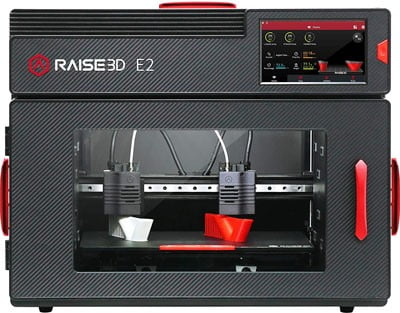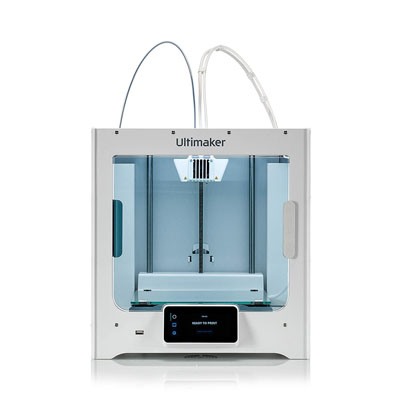Two excellent desktop 3D printer kits are the Raise3D E2 and the Ultimaker S3. Both printers offer amazing features but we will compare them based on build volume, extrusion, and safety. We will base our recommendation on user skill level and project needs.
Raise3D E2
The Raise3D E2 is a fully enclosed desktop 3D printer. It features independent dual extruders, automatic bed leveling, and automatic pause functions.
It has an IDEX, or independent dual extruder, setup. This means that the printer will allow for dual extrusion printing without problems like oozing from the inactive nozzle. Additionally, the printer features Inverse and Duplicate printing, which allow printing of a mirrored version or a carbon copy, respectively. It can either increase printing speed for batches of the same parts or enable faster creation of symmetrical parts. The dual extruders can collaborate on one print or produce two separate prints.
The E2 has a print volume of 330 x 240 x 240 mm. It features automatic bed leveling.
The printer has a sturdy aluminum frame that features an air filtration system in addition to the fully enclosed build area. The enclosed frame keeps sensitive components and moving parts tucked away behind metal panels. Consequently, when the build chamber is opened, printing will automatically pause, providing an excellent safety feature.
The E2 features filament run-out detection and print resume functions. If the filament runs out or breaks, printing will pause to allow the user to replace the filament. When the power fails for any reason, the printing will pause and resume once it is restored. Both features save the user time and materials.
The printer features a removable flexible magnetic build plate. The plate has a silicone coating. This makes removing the finished prints from the machine easier. If users have a backup build plate, they can even swap plates after printing to speed up the process.
It can support materials like PLA, TPU, PVA, ABS, HIPS, wood, flexibles, and more.
Ultimaker S3
The Ultimaker S3 is a partially enclosed desktop 3D printer. It features the ability to print two different materials in the same job, a removable build plate, and material sensors.
Like the Raise3D E2, the Ultimaker S3 features dual extruders. However, the S3’s print volume is smaller than the E2’s.
The Ultimaker S3 has the ability to print two different materials in the same job. This is made possible through the use of its proprietary print cores. These print cores are a multitude of drop-in hot ends that are tailored to specific materials and their print properties. Moreover, the print cores simply click into place with the push of a button, making the printer extremely easy to configure.
Print Bed and Bed Leveling
The S3 features a heated print bed with a 230 x 190 mm removable glass sheet on top. The total build volume is 230 x 190 x 200 mm. Bed leveling is handled by what is called Active Bed Leveling. After the initial calibration where the user sets the desired nozzle height, the S3’s print head will probe a grid across the build plate before each print. It will detect its distance from the bed and automatically compensate for any differences in the level across the area.
Partially Enclosed Print Area
The printer features a partially enclosed print area, with a glass door protecting the front of the machine. This contributes to a more stable atmosphere inside the build area.
Touchscreen UI
The S3 features a 4.7-inch color touch screen UI. It gives access to the printer configuration, maintenance, and directly queues prints from the USB drive.
Cura Connect Portal
The printer benefits from connectivity through the Cura Connect portal. Basically, it can serve as a network host, linking any compatible printer on its local network, sending print jobs to the machines that have the correct print cores and materials prepared for the job.
The S3 has the ability to connect to Cura over WiFi. This allows for wireless transmission of print jobs, remove viewing of the printing progress using an embedded camera, and print queue management.
Other Features
The printer offers 20 micron layer resolution and 60 micron minimum layer height.
Featuring material sensors, the printer will pause in the event of a problem. If there is a blockage or the material has run out, the printing pause and the user will be alerted. This will save the user time and materials.
Our Recommendation
Clearly both printers offer excellent features; however, we must break down the differences before users make a commitment to one or the other. The Raise3D E2 offers independent dual extruders, a large build volume, and a fully enclosed build area. We recommend this printer for classroom settings.
On the other hand, the Ultimaker S3 offers the ability to print two different materials at the same time and high resolution. We recommend this printer for professionals.

